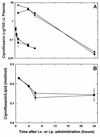Antibacterial efficacy against an in vivo Salmonella typhimurium infection model and pharmacokinetics of a liposomal ciprofloxacin formulation
- PMID: 9449259
- PMCID: PMC105454
- DOI: 10.1128/AAC.42.1.45
Antibacterial efficacy against an in vivo Salmonella typhimurium infection model and pharmacokinetics of a liposomal ciprofloxacin formulation
Abstract
The fluoroquinolone antibiotic ciprofloxacin has been encapsulated into large unilamellar vesicles (LUV) at efficiencies approaching 100%. Drug accumulation proceeded in response to a transmembrane gradient of methylammonium sulfate and occurred concomitantly with the efflux of methylamine. A mechanism for the encapsulation process is described. LUV composed of dipalmitoylphosphatidylcholine-cholesterol (DPPC/chol), distearoylphosphatidylcholine-cholesterol (DSPC/chol), or sphingomyelin-cholesterol (SM/chol) increased the circulation lifetime of ciprofloxacin after intravenous (i.v.) administration by > 15-fold. The retention of ciprofloxacin in liposomes in the circulation decreased in the sequence SM/chol > DSPC/chol > DPPC/chol. Increased circulation lifetimes were associated with enhanced delivery of the drug to the livers, spleens, kidneys, and lungs of mice. Encapsulation of ciprofloxacin also conferred significant increases in the longevity of the drug in the plasma after intraperitoneal administration and in the lungs after intratracheal administration in comparison to free ciprofloxacin. The efficacy of a single i.v. administration of an SM/chol formulation of ciprofloxacin was measured in a Salmonella typhimurium infection model. At 20 mg of ciprofloxacin per kg of body weight, the encapsulated formulation resulted in 10(3)- to 10(4)-fold fewer viable bacteria in the livers and spleens of infected mice than was observed for animals treated with free ciprofloxacin. These results show the utility of liposomal encapsulation of ciprofloxacin in improving the pharmacokinetics, biodistribution, and antibacterial efficacy of the antibiotic. In addition, these formulations are well suited for i.v., intraperitoneal, and intratracheal or aerosol administration.
Figures








Similar articles
-
Antibacterial efficacy of gentamicin encapsulated in pH-sensitive liposomes against an in vivo Salmonella enterica serovar typhimurium intracellular infection model.Antimicrob Agents Chemother. 2000 Mar;44(3):533-9. doi: 10.1128/AAC.44.3.533-539.2000. Antimicrob Agents Chemother. 2000. PMID: 10681314 Free PMC article.
-
Liposome delivery of ciprofloxacin against intracellular Francisella tularensis infection.J Control Release. 2003 Oct 30;92(3):265-73. doi: 10.1016/s0168-3659(03)00358-4. J Control Release. 2003. PMID: 14568408
-
Drug targeting by polyalkylcyanoacrylate nanoparticles is not efficient against persistent Salmonella.Pharm Res. 1998 Apr;15(4):544-9. doi: 10.1023/a:1011921608964. Pharm Res. 1998. PMID: 9587949
-
Current issues in the management of urinary tract infections: extended-release ciprofloxacin as a novel treatment option.Drugs. 2004;64(6):611-28. doi: 10.2165/00003495-200464060-00004. Drugs. 2004. PMID: 15018591 Review.
-
[Rational therapy of salmonella enteritis].Leber Magen Darm. 1994 Mar;24(2):57-8, 61-4. Leber Magen Darm. 1994. PMID: 8196466 Review. German.
Cited by
-
Liposomes as Antibiotic Delivery Systems: A Promising Nanotechnological Strategy against Antimicrobial Resistance.Molecules. 2021 Apr 2;26(7):2047. doi: 10.3390/molecules26072047. Molecules. 2021. PMID: 33918529 Free PMC article. Review.
-
Drug-drug interactions arising from the use of liposomal vincristine in combination with other anticancer drugs.Pharm Res. 2001 Sep;18(9):1331-5. doi: 10.1023/a:1013050330608. Pharm Res. 2001. PMID: 11683249 No abstract available.
-
Laser interferometry analysis of ciprofloxacin and ampicillin diffusion from liposomal solutions to water phase.Eur Biophys J. 2013 Jul;42(7):549-58. doi: 10.1007/s00249-013-0904-2. Epub 2013 Apr 21. Eur Biophys J. 2013. PMID: 23604440 Free PMC article.
-
Ciprofloxacin in polyethylene glycol-coated liposomes: efficacy in rat models of acute or chronic Pseudomonas aeruginosa infection.Antimicrob Agents Chemother. 2002 Aug;46(8):2575-81. doi: 10.1128/AAC.46.8.2575-2581.2002. Antimicrob Agents Chemother. 2002. PMID: 12121935 Free PMC article.
-
Antibacterial efficacy of gentamicin encapsulated in pH-sensitive liposomes against an in vivo Salmonella enterica serovar typhimurium intracellular infection model.Antimicrob Agents Chemother. 2000 Mar;44(3):533-9. doi: 10.1128/AAC.44.3.533-539.2000. Antimicrob Agents Chemother. 2000. PMID: 10681314 Free PMC article.
References
-
- Bermudez L E, Yao-Young A O, Lin J-P, Cogger J, Young L S. Treatment of disseminated Mycobacterium avium complex infection of beige mice with liposome-encapsulated aminoglycosides. J Infect Dis. 1990;161:1262–1268. - PubMed
-
- Bligh E G, Dyer W J. A rapid method of total lipid extraction and purification. Can J Biochem Physiol. 1959;37:911–917. - PubMed
-
- Boman N L, Bally M B, Cullis P R, Mayer L D, Webb M S. Encapsulation of vincristine in liposomes reduces its toxicity and improves its anti-tumor efficacy. J Liposome Res. 1995;5:523–541.
-
- Boman N L, Masin D, Mayer L D, Cullis P R, Bally M B. Liposomal vincristine which exhibits increased drug retention and increased circulation longevity cures mice bearing P388 tumors. Cancer Res. 1994;54:2830–2833. - PubMed
-
- Cullis P R, Hope M J, Bally M B, Madden T D, Mayer L D, Fenske D B. Influence of pH gradients on the transbilayer transport of drugs, lipids, peptides and metal ions into large unilamellar vesicles. Biochim Biophys Acta. 1997;1331:187–211. - PubMed
MeSH terms
Substances
LinkOut - more resources
Full Text Sources
Other Literature Sources

